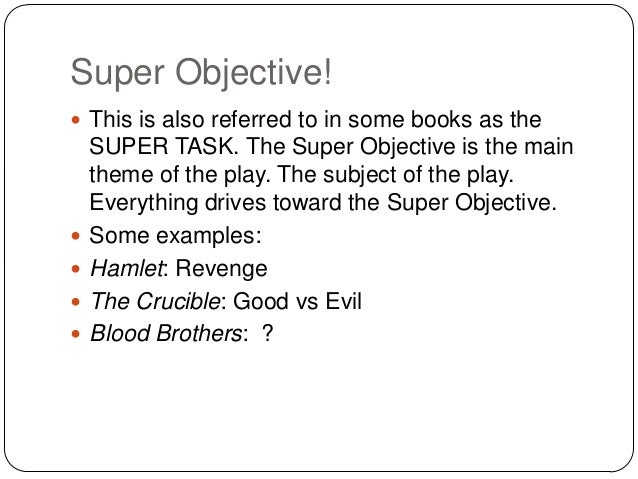- Each Character 27s Super Objective In Hamlet Analysis
- Super Objective Acting
- Each Character's Super Objective In Hamlet Analysis
Each Character 27s Super Objective In Hamlet Analysis
Attention to Hamlet's anger towards Claudius as highlighted through the echoing effect in this technique where he is 'A little more than kin' but 'less than kind'. How does the Hamlet of this scen e fit the model of a malcontent? Hamlet is costumed differently from the other characters ie. Proof plot summary, character breakdowns, context and analysis, and performance video clips. This figure argues, 'Think about society!' And encourages the character to base decisions on how well they satisfy society. In the center is the character, representing the ego, which must strike a balance between the id and superego. Identify the presence of the id, ego, and superego in literary characters previously studied by the class. Feb 25, 2019 Act I. The play begins on a cold night with the changing of the guard. King Hamlet has died, and his brother Claudius has taken the throne. However, for the past two nights, the guards (Francisco and Bernardo) have seen a restless ghost resembling the old king wandering the castle grounds. A character s super objective is the goal the character wants throughout the play. A prominent actor who frequently disguised his appearance in film roles as well as in stage roles was.

This series of short essays about acting is reprinted with the kind permission of Professor John P Palmer of London, Ontario, Canada. He wrote these ‘Theatre Briefs' for use by students and fellow actors during classes and rehearsals. Where he has relied on material from others, they are cited.

- Claudius - I want to . . .

- Each Character 27s Super Objective In Hamlet Analysis
- Super Objective Acting
- Each Character's Super Objective In Hamlet Analysis
Each Character 27s Super Objective In Hamlet Analysis
Attention to Hamlet's anger towards Claudius as highlighted through the echoing effect in this technique where he is 'A little more than kin' but 'less than kind'. How does the Hamlet of this scen e fit the model of a malcontent? Hamlet is costumed differently from the other characters ie. Proof plot summary, character breakdowns, context and analysis, and performance video clips. This figure argues, 'Think about society!' And encourages the character to base decisions on how well they satisfy society. In the center is the character, representing the ego, which must strike a balance between the id and superego. Identify the presence of the id, ego, and superego in literary characters previously studied by the class. Feb 25, 2019 Act I. The play begins on a cold night with the changing of the guard. King Hamlet has died, and his brother Claudius has taken the throne. However, for the past two nights, the guards (Francisco and Bernardo) have seen a restless ghost resembling the old king wandering the castle grounds. A character s super objective is the goal the character wants throughout the play. A prominent actor who frequently disguised his appearance in film roles as well as in stage roles was.
This series of short essays about acting is reprinted with the kind permission of Professor John P Palmer of London, Ontario, Canada. He wrote these ‘Theatre Briefs' for use by students and fellow actors during classes and rehearsals. Where he has relied on material from others, they are cited.
- Claudius - I want to . . .
